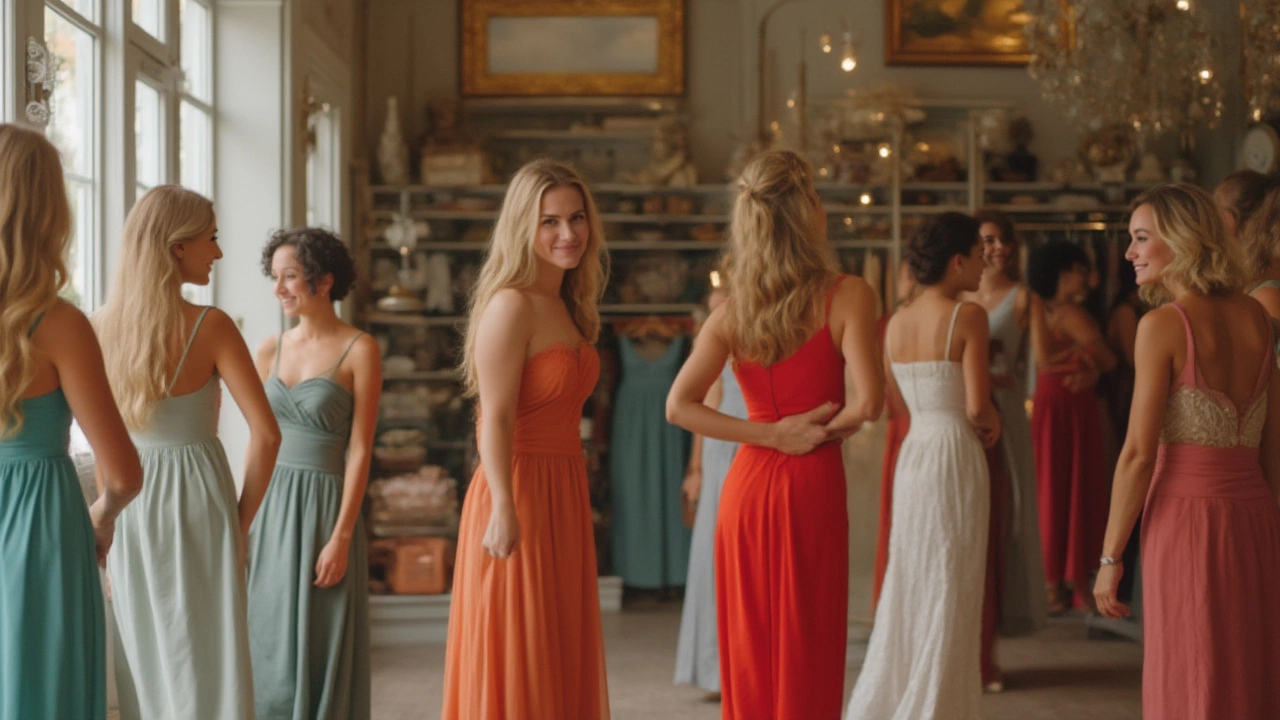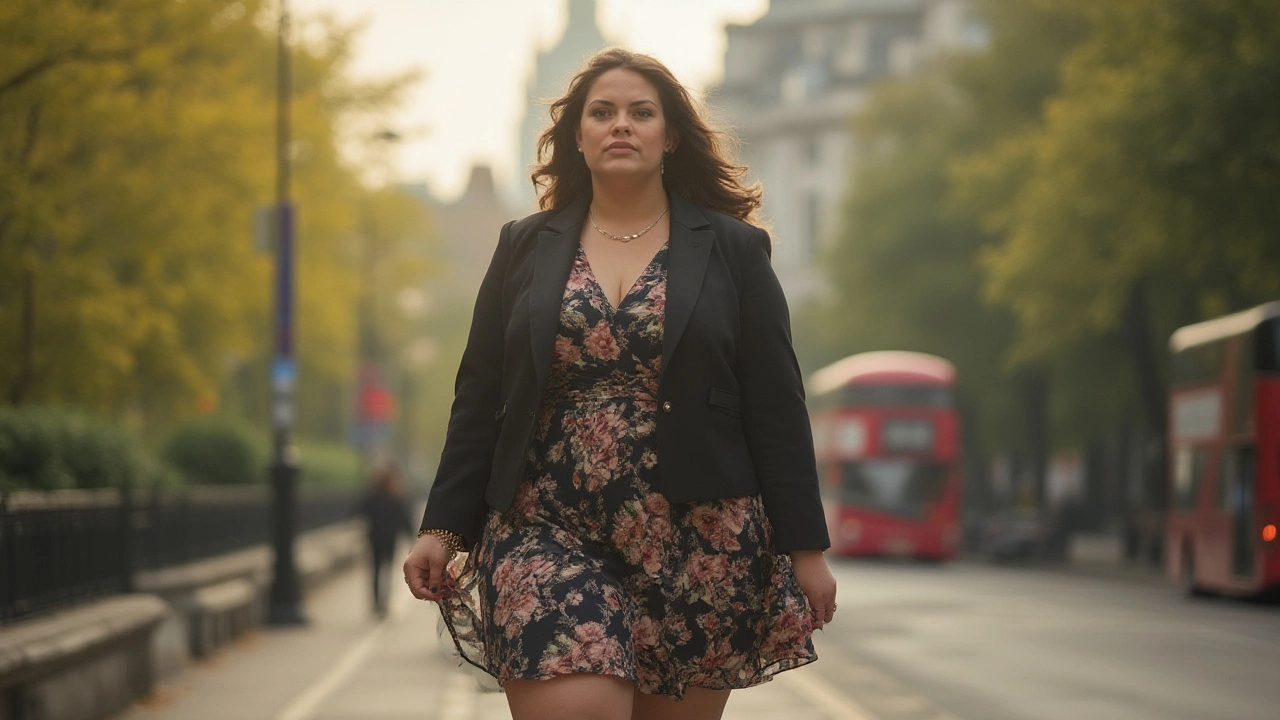The Best Dresses to Flatter and Conceal a Big Stomach

- Cleo Fairchild
- 12 July 2025
- 0 Comments
If you ever tried on a sleek bodycon dress and immediately felt like you were on display at a baby shower (with people wondering whether or not you're expecting), you're not alone. Shopping for a dress that flatters your body—without making you feel like you're wearing a tent—can feel impossible. But dress designers know what they're up against, and there are clever styles and tricks that really do the job.
Why Dress Shapes Matter: The Science Behind the Silhouette
Dresses leave nowhere to hide, right? Actually, that's not true. Choosing the right silhouette can transform how you look and feel. The science is simple: clothing that subtly draws the eye to where you want them or creates new lines can make all the difference. In fact, studies from the Fashion Institute of Technology have found that people tend to estimate waist size based on the outline, not the actual measurement. So, it’s all about shape illusions.
The classic go-tos for tummy camouflage: Empire waist, A-line, wrap and shift dresses. Take, for example, the empire-waist dress. The seam sits right under the bust and then flows out, which tricks the eye into focusing on the smallest area of your torso. Queen Victoria made that style famous, and it’s still a favorite for women who want to accentuate their chest while skimming their midsection.
A-line dresses are another secret weapon. They start narrow at the shoulders and widen toward the hem, creating a gentle flare that doesn't hug your stomach. This shape is so good, even Kate Middleton relies on A-lines for official photos.
What about wrap dresses? Diane von Furstenberg practically invented the wrap dress in the 1970s, and it’s been a staple for generations. The adjustable tie lets you fit and flare exactly where you want, and the diagonal line of the wrap naturally draws eyes downward, away from the midsection.
If simple is your style, don’t ignore shift dresses. They have a loosened fit straight down, which means nothing clings to your belly. Minimal fuss and no need for shapewear (unless you want to go wild).
There's also a lot of talk about ruching—those gathered, pleated bits of fabric that create texture across your torso. While subtle ruching can work wonders, too much can end up overemphasizing what you’d rather hide. The trick is balance: small folds at the side, not heavy bunching front and center.
Understanding dress shapes is half the battle. Looking at the fabric and pattern next is just as important—because the wrong choice can undo all the silhouette magic.
Fabric and Patterns: The Unsung Heroes of Figure Flattery
The style is only the start—fabric makes or breaks a dress when it comes to hiding a belly. Some materials hug every lump and bump, while others work like a gentle airbrush filter. When your middle is your main concern, always look for structured fabrics that hold their shape—think crepe, ponte, or thicker jersey. These never cling, and they give a crisp outline that hides what you want hidden.
If you love the thought of floaty dresses, pick woven materials with a bit of weight to them, like cotton poplin or viscose blends, over anything thin and clingy (satin, I see you). Thin stretch fabrics might seem dreamy in the dressing room, but once you start moving, they reveal every food baby.
Patterns are your friend, but not all prints are created equal. Busy prints, small florals, or scattered dots distract the eye—whereas bold horizontal stripes or massive flowers do the opposite. There’s an old stylist trick: vertical elements, like long seams, stripes, or rows of buttons, pull attention up and down, not side to side. It sounds basic, but even the tiniest vertical stripe can actually make you look slimmer in photos and video calls, according to surveys from image consultants in London.
Don’t overlook color blocking, either. Dresses with dark side panels and lighter centers create a curved outline, visually cinching your silhouette. This trick is seen everywhere from the red carpet to everyday brands. And if you always go for black because you think it’s slimming, try deep jewel tones or bottle green—they’re just as flattering and way less predictable.
Another tip: avoid shiny fabrics. Anything that reflects light (satin, high-sheen silk, lamé) can highlight your least favorite areas. Matte finishes keep things soft and blurred instead of sharp and defined.
Still feeling unsure? Tailoring can save almost any dress. For under $25, a tailor can tweak a dress at the shoulders or hem, which changes the way everything drapes. Small changes can lead to a dramatic difference, often more so than sizing up or down.
Here’s a comparison table for quick reference on common fabrics and their impact on hiding a larger stomach:
| Fabric | Pros | Cons | Score (1-5) |
|---|---|---|---|
| Ponte knit | Structured, doesn't cling | Can feel thick in summer | 5 |
| Cotton poplin | Breathable, holds shape | Wrinkles easily | 4 |
| Jersey | Soft, stretchy, comfy | Emphasizes lumps | 2 |
| Satin | Luxurious look | High sheen, unforgiving | 1 |
| Crepe | Textured, forgiving | Can be warm | 4 |

The Little Details: Features That Work (and Those That Don’t)
Now, let’s talk extras—because the bits designers add to dresses can be your secret weapon. Peplum hems (the short, flared ruffle at waist level) can completely disguise the belly, especially in pencil dresses or fit-and-flare styles. But don’t go overboard—too much volume below the waist and you can look weighed down or extra boxy.
Belted waistlines are worth a shot if you want some shape, but location is everything. Belts sitting at the true waist look best if you have a defined spot there; if your shape is more straight, try dresses with a soft, loose tie just under the bust (again, the magic of empire lines).
Pockets and pleats sound fun but can go either way. Side pockets sewn into the seam tend to be harmless, but big front pockets or bulky decorative pleats draw focus. Same goes for tiers—dresses with multiple horizontal layers can break up your outline in a good way (if the top layer falls just below your ribcage), but if they’re too extreme, they add bulk instead of hiding it.
Necklines make a subtle but huge difference. V-necks or deep scoop necks visually lengthen the body and bring attention upward toward your face. Pair that with a delicate pendant and, suddenly, your whole look feels lighter. The opposite—high necks, turtlenecks, or boatnecks—make the upper body wider and, you guessed it, accentuate the belly.
Then there’s the world of shapewear. Some love it, some call it modern-day armor, but you don’t have to squeeze into a corset to get a smooth silhouette. High-waisted briefs, lightweight control slips, or even seamless biker shorts can stop a dress from catching on your tummy, making everything glide over more smoothly. A good tip? Look for shapewear with a non-slip waistband—no one enjoys yanking things back up all day.
If you still feel like you’re missing something, experiment with layering. A cropped denim jacket, longline blazer, or even a loose kimono can break up your outline and create vertical lines. Layers don’t have to mean hiding—when strategically chosen, they add interest and divert attention away from your midsection.
Don’t forget shoes and accessories. If you wear heels or wedges, you elongate your legs, which in turn balances out your silhouette. Chunky statement necklaces or bold earrings shift focus north. Crossbody bags worn slightly higher also add a subtle vertical line right where you want it.
Fashion’s about trying things and figuring out what feels best. If you find a dress you love, snap a selfie from all angles. Sometimes what you see in the mirror is different from what the camera shows. And if you ever doubt your choices, remember: even stylists break their own rules for the perfect look.
Real-World Advice and Fresh Trends for Every Shape
In 2024, oversized shirt dresses and utility styles are trending hard. These tend to be cut generously through the body, making them forgiving, but smart styling is key. Add a belt just above your natural waist (as high as you dare) to keep things feminine, or wear open over a fitted tank and leggings for a layered effect.
Here’s a quick list of styles to try if you want to consistently hide your *belly* (here’s to that SEO keyword):
- Empire waist maxis—floaty and always easy
- Structured A-lines with hidden side pockets
- Subtle wrap dresses with patterned prints
- Peplum sheaths for special occasions
- Monochrome shirt dresses belted at the bust
- Colourblocked midis with vertical stripe details
One fun fact: a poll by Simply Be, a UK-based inclusive fashion brand, showed that 68% of women said they felt best in dresses with a defined top and relaxed bottom—not full shape-hiding tents, but styles that allow for movement and breathing while offering an outline. No surprise there.
If shopping online, always check the returns policy. Sizing can be a mystery, as one brand’s 12 is another’s 16. Measure your favorite dress flat at home, and compare it with item dimensions listed. Read buyer reviews for hints on fabric thickness, fit through the stomach, and overall wearability.
And if you’re having one of those days where nothing feels right, throw on a lightweight kimono, grab a bag in a jolt of color, and go face the world anyway. Fashion isn’t just about hiding—sometimes, it’s about showing up exactly as you are, with a few clever tricks in your back pocket.
Remember, confidence outshines any dress. Still, when the right style flatters your shape and makes you smile at your own reflection, that’s magic—that's why these dress styles are still winning fans decade after decade.


